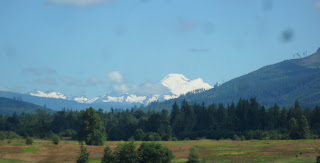Another beautiful day in the Pacific Northwest found us once again on the motorcycle. This time we headed up to the Sumas border crossing into British Columbia. It is the perfect ride - through the Skagit and Whatcom County valleys with mountain and river views the entire way. It is just about 100 miles - a perfect day trip.
We headed out Jordan Road to Arlington, following the South Fork of the Stillaguamish River.
Highway 9 between Arlington and Sedro Wooley is dotted with lakes. We followed long, narrow Lake McMurray for a couple of miles, and then entered the forest for a few miles.
We had peek-a-boo views of Big Lake for many miles.
Mount Baker in the background, flourishing dairy farm fields in the foreground as we passed Big Lake and neared Clear Lake.
There was no place to stop in traffic as we went through Sedro Wooley, but the plaza when we entered the town was full of the most gorgeous flower display.
Mt Baker got closer and closer as we neared Acme, where we found the cleanest nicest biker bar we have ever been to.
Of course, it isn't just for bikers! The food was excellent, and the view was wonderful.




















